pandas.DataFrame.where和mask 解读
1.前言背景
没怎么用过df.where 都是直接使用loc、apply等方法去解决。


可能是某些功能还没有超出loc和apply的适用范围。
2.进入df.where和df.mask
DataFrame.where(self, cond, other=nan, inplace=False, axis=None, level=None, errors='raise', try_cast=False)
note:Replace values in DataFrame with other where the cond is False.
我们还是要看一下官网对里面每一个参数的解释:
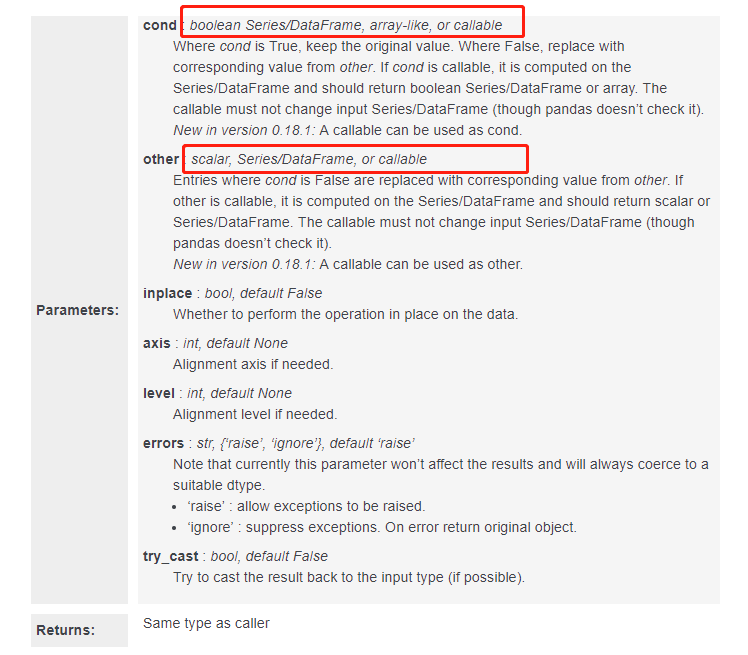
红色是特别注意的,往往无论是博客还是案例一般给不会穷举所有可能,只有把api的每一种可能理解了,才能无招胜有招。
大体意思:就是对一个DataFrame进行条件判断当他的条件不符合就选择other参数里面的数值。
其实它拥有一个相反的函数where<==>mask:where条件不符合进行替换,mask是条件符合进行替换。
DataFrame.mask(self, cond, other=nan, inplace=False, axis=None, level=None, errors='raise', try_cast=False)
note:Replace values in DataFrame with other where the cond is True.
我们还是要看一下官网对里面每一个参数的解释:
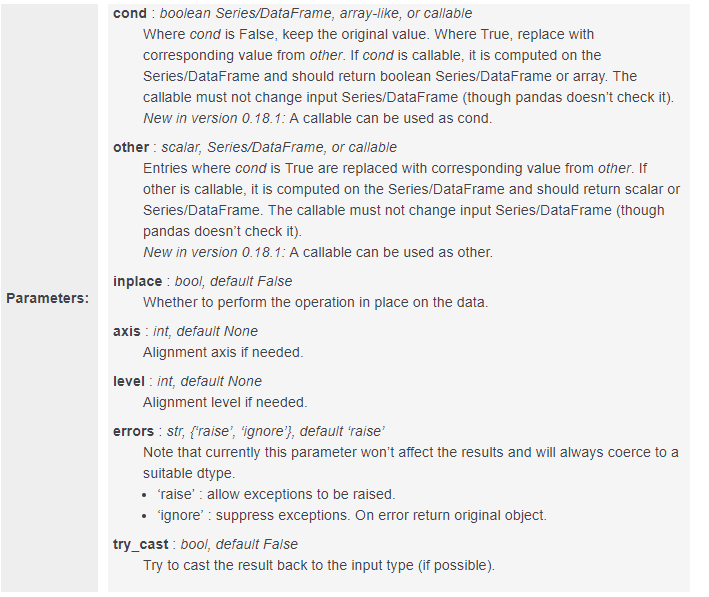
也可以看到两者参数并无差异。
3.与np.where的异同?

np.where(condition, [x, y]),这里三个参数,其中必写参数是condition(判断条件),后边的x和y是可选参数.那么这三个参数都有怎样的要求呢?
condition:array_like,bool ,当为True时,产生x,否则产生y
简单说,对第一个参数的要求是这样的,首先是数据类型的要求,类似于数组或者布尔值,当判断条件为真时返回x中的值,否则返回y中的值
x,y:array_like,可选,要从中选择的值。 x,y和condition需要可广播到某种形状
x和y是可选参数,并且对这两个参数的数据类型要求只有类似数组这一条,当条件判断为true或者false时从这两个类似数组的容器中取数.
4.实际案例
4.1mask和where 的区别,np.where(cond,df1,df2)
s = pd.Series(range(5))
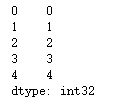
s.mask(s > 0)

s.where(s > 0)

ss = pd.Series(range(10,20,2))
import numpy as np
np.where(s>2,s,ss)

4.2探究cond : boolean Series/DataFrame, array-like, or callable和other : scalar, Series/DataFrame, or callable
下面我在cond使用callable类型,在other参数中使用callable参数
df = pd.DataFrame(np.arange(10).reshape(-1, 2), columns=['A', 'B'])
df
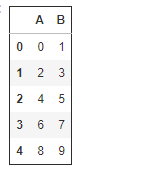
def cond1(x):
return x%3==0
def mult3(x):
return x*3
df.where(cond1, mult3)
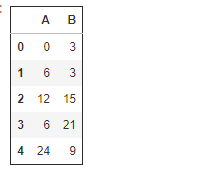
pandas.DataFrame.where和mask 解读的更多相关文章
- pandas.DataFrame学习系列1——定义及属性
定义: DataFrame是二维的.大小可变的.成分混合的.具有标签化坐标轴(行和列)的表数据结构.基于行和列标签进行计算.可以被看作是为序列对象(Series)提供的类似字典的一个容器,是panda ...
- pandas.DataFrame的pivot()和unstack()实现行转列
示例: 有如下表需要进行行转列: 代码如下: # -*- coding:utf-8 -*- import pandas as pd import MySQLdb from warnings impor ...
- pandas DataFrame apply()函数(1)
之前已经写过pandas DataFrame applymap()函数 还有pandas数组(pandas Series)-(5)apply方法自定义函数 pandas DataFrame 的 app ...
- pandas DataFrame apply()函数(2)
上一篇pandas DataFrame apply()函数(1)说了如何通过apply函数对DataFrame进行转换,得到一个新的DataFrame. 这篇介绍DataFrame apply()函数 ...
- 把pandas dataframe转为list方法
把pandas dataframe转为list方法 先用numpy的 array() 转为ndarray类型,再用tolist()函数转为list
- pandas DataFrame.shift()函数
pandas DataFrame.shift()函数可以把数据移动指定的位数 period参数指定移动的步幅,可以为正为负.axis指定移动的轴,1为行,0为列. eg: 有这样一个DataFrame ...
- pandas DataFrame applymap()函数
pandas DataFrame的 applymap() 函数可以对DataFrame里的每个值进行处理,然后返回一个新的DataFrame: import pandas as pd df = pd. ...
- pandas DataFrame(3)-轴
和numpy数组(5)-二维数组的轴一样,pandas DataFrame也有轴的概念,决定了方法是对行应用还是对列应用: 以下面这个数据为例说明: 这个数据是5个车站10天内的客流数据: rider ...
- pandas DataFrame(4)-向量化运算
pandas DataFrame进行向量化运算时,是根据行和列的索引值进行计算的,而不是行和列的位置: 1. 行和列索引一致: import pandas as pd df1 = pd.DataFra ...
随机推荐
- 【转帖】sysbench的安装和做性能测试
iMySQL | 老叶茶馆 sysbench的安装和做性能测试 http://imysql.cn/node/312 我仿照这个学的 但是 需要用更新的版本才可以. By yejr on 14 六月 ...
- 记录一次线上yarn RM频繁切换的故障
周末一大早被报警惊醒,rm频繁切换 急急忙忙排查 看到两处错误日志 错误信息1 ervation <memory:0, vCores:0> 2019-12-21 11:51:57,781 ...
- Scala当中什么是Transformation和 Action,以及它们俩的区别是什么?
[学习笔记] 一个完整的RDD任务由两部分组成:Transformation和 Action.Transformation用于对RDD的创建,还可以把老的RDD通过Transformation来生成新 ...
- 基于DNS(Consul)高可用
DNS 推荐从Bind-DLZ入手,资料多可控制度更好(查询DNS记录SQL可定制)据说性能差 Bind-DLZhttps://www.cnblogs.com/saneri/p/8178065.htm ...
- XML工具——xmlbeans的使用
一.安装xmlbeans 1.下载xmlbeans 下载地址:https://gitee.com/shizuru/xmlbeans-2.6.0 2.解压,此处以解压至D盘根目录为例 3.配置环境变量( ...
- linux mysql 数据库操作导入导出 数据表导出导入
linux mysql 数据库操作导入导出 数据表导出导入 1,数据库导入 mysql -uroot -p show databases; create database newdb; use 数据库 ...
- 怎样使用yum安装nginx
yum install -y nginx 以上.
- 轻松搭建CAS 5.x系列(1)-使用cas overlay搭建SSO SERVER服务端
概要说明 cas的服务端搭建有两种常用的方式: 1. 基于源码的基础上构建出来的 2. 使用WAR overlay的方式来安装 官方推荐使用第二种,配置管理方便,以后升级也容易.本文就是使用第 ...
- python selenium3 模拟点击+拖动+保存验证码 测试对象 58同城验证码
#!/usr/bin/python # -*- coding: UTF-8 -*- # @Time : 2019/12/5 17:30 # @Author : shenghao/10347899@qq ...
- 【php设计模式】观察者模式
当对象间存在一对多关系时,则使用观察者模式.比如,当一个对象被修改时,则会自动通知它的依赖对象.观察者模式属于行为型模式. <?php class Subject{ private $obser ...
